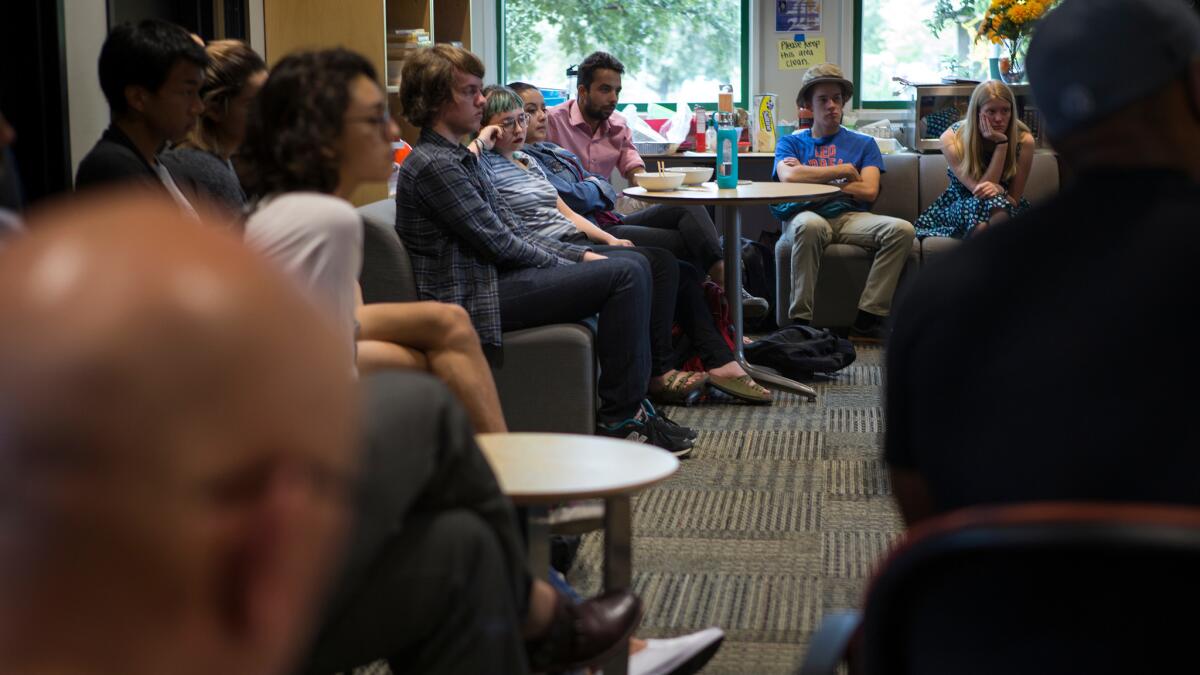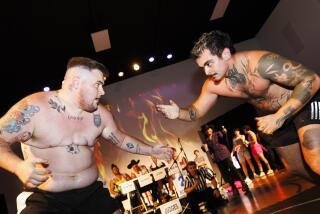At the University of Redlands, guys meet to parse what it means to be men

Marcus Garcia raised his hand in a circle of classmates and stumbled through a question many of them had pondered but not out loud.
Does pornography change the way young men are attracted to women? And are those feelings normal?
Curiosity charged the silence in the room, where Garcia and fellow University of Redlands students were encouraged to share their thoughts without fear of judgment.
On college campuses these days, it seems as if everyone has a safe space, whether they be people of color, Muslim or Jewish, queer or questioning, women facing oppression. But what about guys? What about the 18-year-old, 19-year-old, 20-year-old fellow shaped by society into thinking that being tough, being hypersexual, being aggressive goes hand-in-hand with being a man?
At this close-knit liberal arts school tucked into the San Bernardino Valley, campus leaders are encouraging young men to get together and … talk. About emotions, about body image, about whether objectifying women and chugging beer actually makes one more masculine.
DUDES, which stands for Dudes Understanding Diversity and Ending Stereotypes, is the school’s take on a counterintuitive concept: the men’s center. Through pop-up workshops, speaker series and social activities, students are prompted to explore the challenges they may not even realize they face.
Discussions like the one Garcia recently attended are candid but structured. The talk that day, “PORN: Good, Bad or Ugly?”, was led by Catherine Salmon, a professor of psychology and human sexuality.
Garcia’s question, she informed the group, was one researchers had wondered as well.
One study, she said, interviewed men in happy relationships. But after being shown photos of models and porn stars, every single man found his partner less attractive.
“Whether they were naked, clothed, it didn’t matter,” she said. “You think you have a 10, but then you realize there could be a 12…. It’s an unfortunate reality of a world where you’re exposed to so many stimuli.”
Chairs creaked, more hands went up. Assured they were not alone in their thoughts, the men had much more to share.
“To realize, wow, because of pornography and Hollywood, I’m looking at a girl and not thinking she’s as beautiful because I’ve been programmed to think this and that about women,” said Garcia, a junior. “There are stereotypes placed on men that we have to face, which pressures us to make decisions that we don’t have to make.”
When a friend told him about DUDES, it seemed like a perfect fit. His studies center on social activism, and he has often felt judged for seemingly inconsequential things such as wearing pink or asking for help.
Now phrases such as “authentic masculinity” and “taking off the man mask” work their way into his conversations with peers.They talk about sex, drugs, violence, Vin Diesel and the empathetic softie played by Michael Cera in the movie “Juno” and whether it’s possible to embody both characters at once.
Men’s centers still are uncharted territory. A handful of colleges across the nation have tried them. It’s an unexpected approach to identity awareness — one that easily could be misunderstood.
But helping young men unlearn the myths of masculinity, advocates say, profoundly changes the sort of thinking and behavior that can lead to violence and sexual assault. And it prepares them, when they graduate, to break down gender walls that still exist in the workplace and society.
“We draw awareness to a lot of these things that we as men do and then challenge it — is that something we should continue or something that we should change?” said Zack Ritter, associate director of campus diversity and inclusion at Redlands and co-founder of DUDES.
DUDES began as part of an effort to improve male student retention. At most U.S. colleges, including Redlands, men tend to withdraw or take leaves of absence at higher rates than women. Redlands formed a committee to find out why.
They learned that, outside of fraternities and sports teams, most of those involved in the dozens of extracurricular activities on campus were women. The more involved they were, the more they felt connected to a community, the more motivated they were to stay in school.
Men make up just under half of Redlands’ undergraduate population of 2,445 students — and about 40% of them are in fraternities or participate in athletics. So what does the school have to offer the other 60%?
Young men are less likely than young women to “just grab coffee,” so creating regular activities that bring them together can help them start to talk and develop friendships, said Fredric Rabinowitz, a professor who studies male psychology and advises the retention committee.
“What we’re trying to do is catch the guys that aren’t in a club, the guys who don’t belong to anything,” he said. “We’re catching those who are struggling academically, the men who were cut off of sports teams, the men who were just in their rooms playing video games.”
Men are hungry for interpersonal connection — if you provide the space, said Jon Davies, the counseling psychologist who in 2002 co-founded one of the first college men’s centers, at the University of Oregon.
When Davies ran focus groups to figure out what young men wanted in a center, he found that they enjoyed getting together to answer his questions.
“They said ‘Hey, Jon, we really like this, create more opportunities for us to get together in small groups to talk about our concerns, but, ” he said, laughing, “call it something different than counseling.’”
The University of Massachusetts Amherst now has a Men and Masculinities Center to “interrogate and deconstruct traditional forms of masculinity.” Last fall, Trinity College in Hartford, Conn. created a Masculinity Group to talk about the unrealistic expectations that arise from “toxic masculinity.”
At Redlands, Ritter moved into the dorms last year and with a colleague, Reggie Robles, began hosting retreats, poetry slams and discussions on topics such as men and gun culture and male careers in the nonprofit world. In one playful activity, young men tried to walk in 4-inch red heels as a way to put themselves in someone else’s shoes.
As interest grew, the duo developed “DUDES: Understanding Male College Student Journeys,” a one-credit course to further explore such ideas.
Take basketball legend Wilt Chamberlain, Ritter told the class recently. He was terrible at free throws, so he switched to shooting them underhand, “granny style.”
“It’s easier, right?” Ritter said, as he had students try to toss a ball into a trash bin both ways. “He upped his game, scored 100 points, but he still switched back because he didn’t want to look like a ‘sissy’…. Why? What does this say about peer pressure?”
On any given day, young men now wander in and out of the same rooms that house the Multicultural Center and women’s center (recently renamed the Center for Gender Justice). They talk masculinity in a room decorated with flyers for Eid celebrations and performances of “The Vagina Monologues.” It’s a fitting setting for what Ritter describes as a “traveling men’s center.”
DUDES works with other campus groups to look at male identity through different lenses, such as how it felt to be a Middle Eastern man after the San Bernardino terrorist attack. It welcomes women. When some suggested DUDES was recreating an old boys club, Ritter said their perspective was needed to teach men to be men. “When women speak in these circles,”he said, “lightbulbs go off, even for me.”
Experts praise Redlands’ inclusive approach, but acknowledge reasons why such centers are rare on college campuses.
“A lot of people don’t see the need for it, but we also don’t do a good job of framing it,” said Frank Harris III, a San Diego State University professor who studies male gender identity and masculinity issues. Efforts to address sexual assault, for example, often focus on making sure women have more whistles or blue lights on campus rather than stressing that certain male behaviors need to be unlearned.
Still, he said, “we have to be mindful of what these all-male communities look like” and what versions of masculinity they’re espousing. If not, it might just be a bunch guys getting together and reinforcing old habits.
There’s still work to do at Redlands, said Emari McClellan, a middle linebacker who has been trying to convince others on the football team to participate in DUDES.
It’s challenging, he admitted, to call them out for certain things they say. Often, he pulls them aside after practice.
“Hey, some things that you’re saying — you can change that,” he tells them. “Come to DUDES. The stuff we talk about is cool.”
He doesn’t mind sticking his neck out, he says, if he can expand others’ thinking the way DUDES has his.
“You can be a man in modern day society but also express emotions and not be called feminine,” he said. “I can be myself and still be accepted.”
On a recent Thursday, he rushed from practice to DUDES class. As he got settled, he looked up and grinned.
One of his teammates had followed him in.
Follow @RosannaXia for more education news.
ALSO
Mother of 14-year-old boy killed by LAPD in Boyle Heights files legal claim
Backpage says criminal charges by Kamala Harris are ‘election year stunt’
‘Repugnant,’ ‘demeaning,’ ‘vulgar’: Republicans react to Trump’s remarks, and Democrats chime in too
More to Read
Sign up for Essential California
The most important California stories and recommendations in your inbox every morning.
You may occasionally receive promotional content from the Los Angeles Times.











